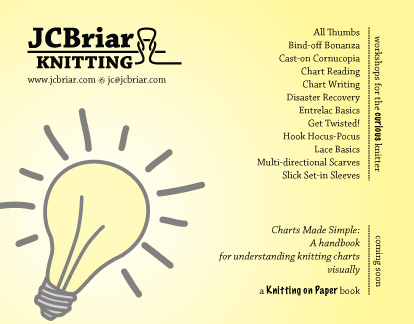Work avoidance as a productivity tool
By JC | June 1, 2010
Okay, I admit it: I fibbed yesterday when I said I finally managed to get Camille on Patternfish because I had gotten Yachats out of the way. No, truth be told, it was an example of work avoidance as a productivity tool.
Maybe you’ve done this too, once or twice. Maybe, when faced with a to-do list full of icky tasks, you chose to ignore them all in favor of something else, something slightly less icky. You know, like cleaning the bathroom. The to-do list is still staring you in the face—that’s your work avoidance. But at least the bathroom’s clean—that’s your productivity.
This isn’t to say that posting a pattern on Patternfish is as icky as cleaning the bathroom—far from it! The point is that it’s a good deal less icky than the other things on my to-do list. Or, I should say, the other Thing, with a capital T.
This other Thing is a book. I’ve been working on it for… oh, longer than I care to admit. Some of you got to hear about it at Stitches South, at the Teachers à la Carte luncheon, where I passed out these postcards:
See the “coming soon” part at the bottom? Charts Made Simple: A handbook for understanding knitting charts visually. Geared as an in-your-knitting-bag version of my Chart Reading class, the book’s first two chapters get you started with charts:
- The Big Picture sheds light on why charts are drawn to resemble knitted fabric, and how this governs the way you read charts.
- Staying on track suggests strategies for keeping your place within a chart, and for knitting according to a chart with a minimum of goofs.
Four more chapters dive into greater detail:
- Cable symbol sensibility introduces you to the dazzling realm of cable symbols, and shows how you can unscramble them without always running to a chart’s key for help.
- Charts that show shape explores the idiosyncrasies of charts shaped to match garment pieces, such as shaping implied via chart outlines only, multiple outlines for multiple sizes, and pivot stitches.
- Counting stitches dispels the notion that counting chart squares is the same as counting stitches, pointing out that paying attention to the symbols within the squares is the secret to figuring out how many stitches you ought to have on your needles.
- Repeated stitches draws parallels between the * and [] of written instructions and the repeat lines, boxes, or brackets of charted instructions, explaining how to work repeated stitch patterns flat and in the round.
At this point, I’ve nearly completed a rough draft. Ninety percent of the work is done; 90% of the effort is behind me. But, as the joke goes, that last 10% of the work is going to require another 90% of the effort.
Or so it seems, anyway. My to-do list includes completing a handful of illustrations, re-working a few sections for clarity and consistency, finessing and (if necessary) re-working the layout, getting the book tech-edited, and fixing the gaffes the tech editor discovers.
Oh, and since I plan to self-publish (yes, I’m a glutton for punishment), the to-do list also includes choosing a printer, making umpteen print choices (trim size, cover weight, paper weight, paper finish, binding… shall I go on?), setting up relationships with distributors, and marketing. These tasks, being new to me, qualify as extra-icky.
You get the idea. Posting Camille on Patternfish was a way of feeling productive while avoiding The Book. But that sort of productivity can’t go on a whole lot longer. I’m scheduled to hand the book over to a tech editor in mid-August. I’ve got to get crackin’ to get it ready by then.
Just after I finish cleaning the bathroom.




4 Comments